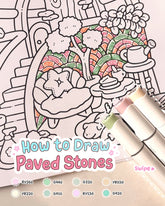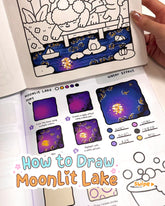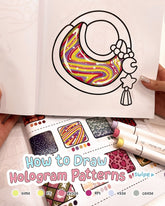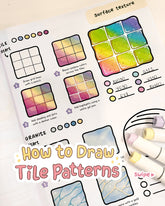How to Blend Alcohol Markers for Beginners?
Table of Contents
Blending with alcohol markers feels almost magical when it works right and the good news is you don’t need fancy tricks to get there. Once you understand the simple flow of how these markers behave, your colors start melting together in the prettiest way.
Take it slow, enjoy the moment and we’ll build everything up step by step so your blends look smooth and effortless!
Method 1: Light to Dark

This is the easiest method for beginners and a great example of what alcohol markers are used for, building color gradually while staying in control.
How to do it:
- Start Light: Pick a small area, like a leaf, and color it all with your lightest marker. This lays down wet ink and preps the paper.
- Add Medium: While the light color is still wet, add your medium color where you want shadows, covering about half of the light area.
- Blend the Line: Go back with the light marker and gently color over the line where the light and medium meet. Use small circles or a soft back-and-forth motion.
- Add Dark: Use the darkest color in the smallest area, usually at the base or deepest shadow.
- Blend Again: Blend dark to medium with your medium marker, then blend medium to light with the light marker.
Quick Tips for Success:
- Work in small sections: Alcohol ink dries fast, so color one leaf or small area at a time.
- Don’t press too hard: Let the marker flow naturally. Layer gradually for smooth blends.
- Marker type: Brush or chisel tips work best for blending; experiment to see what feels comfortable.
And that’s it! You’re just layering your colors little by little, keeping it smooth and easy.
Method 2: Dark to Light

This is the reverse of the light-to-dark method and it’s a great way to practice using an alcohol blender marker to smooth transitions as you go. It’s perfect when you want your darkest shadows strong right from the start.
How to do it:
- Start Dark: Lay down your darkest color in the small area that holds the deepest shadow.
- Add Medium: With the dark ink still wet, use your medium marker. Overlap it slightly at the edge of the dark area, and pull out further.
- Add Light: While the medium is still wet, apply your lightest marker. Start at the edge of the medium ink and drag it out toward the lightest part of the area.
- Re‑Blend (Optional): Go back with your medium marker to soften the dark‑to‑medium line, or use the light marker to smooth the medium‑to‑light transition.
Quick Tips: Layer lightly at first, you can always add more.
Method 3: Feather Blending

Want your fur, hair, or tiny leaves to look alive? This flicking method does just that.
How to do it:
- Start with darkest color at the base and flick outward with quick wrist motions, lifting the tip at the end.
- Add your medium color, flicking over the dark strokes and extending slightly further.
- Finish with your lightest color, flicking over the medium strokes all the way to the tip.
Quick Tips for Beginners: Keep your flicks short and light at first, longer strokes can be added once you’re comfortable.
Method 4: Stippling Technique

Want something more than a smooth gradient? This method is all about texture, perfect for fuzzy sweaters, starry skies, or leafy bushes.
How to do it:
- Start with the dark shade and dot closer together in the shadow area.
- Switch to the medium shade and dot a little looser around the edges.
- Use the light shade to sprinkle just a few dots in the bright spots.
- Adjust the medium and light dots until the blend feels nice and soft.
Common Blending Mistakes & How to Fix Them
Even experienced artists have moments where blends don’t look right. If you’re just starting, these are the usual slip-ups and how to handle them.
1. Coloring Too Large an Area at Once
- Mistake: Trying to blend a big section all at once
- Why It Happens: Alcohol ink dries fast, so colors don’t merge smoothly
- Fix: Work in small sections, a few inches at a time. Blend while the ink is still wet so the colors flow into each other naturally.
2. Pressing Down Too Hard
- Mistake: Using too much pressure while coloring
- Why It Happens: Pressing harder won’t improve coverage and can damage the nib
- Fix: Use light, even strokes. Let the marker glide across the paper, it spreads better without streaks.
3. Using Dirty or Overworked Nibs
- Mistake: Blending with stained, frayed, or clogged tips
- Why It Happens: Ink buildup or overuse makes blending uneven
- Fix: Scribble on scrap paper to clean the nib, rotate markers, and replace damaged tips. Clean nibs blend smoothly and give better control.
4. Not Swatching Colors First
- Mistake: Assuming the cap matches the ink perfectly
- Why It Happens: Marker caps rarely match the true color
-
Fix: Test colors on scrap paper first. Swatching helps you see how shades mix and avoids surprises on your project.
FAQs
What is an alcohol blender marker and when should I use it?
An alcohol blender marker contains clear alcohol-based ink. Use it to soften edges, blend two colors smoothly, or lighten areas. It doesn’t add color but helps create seamless transitions and gradients.
How long does it take for alcohol marker blends to dry?
Alcohol marker ink dries quickly, usually 30–60 seconds depending on paper and ink layers. Thicker layers or heavy blending may take a bit longer.
Why are my alcohol marker blends coming out blotchy?
Blotchy blends usually happen because the ink dried before layering, colors skipped a mid-tone, or too much pressure was applied. Work in small sections, layer gradually, and use gentle strokes.
What are alcohol markers?
Alcohol markers are pens filled with alcohol-based ink. They dry fast, blend smoothly and work well on marker-friendly paper. They come in a wide color range for illustration, coloring and design.
How to store alcohol markers?
Store horizontally with caps tightly closed to prevent drying. Keep away from heat or direct sunlight. Rotating markers occasionally keeps ink flow even.
Are alcohol based markers toxic?
Most alcohol markers are low-toxicity but are not meant to be ingested. Use in a ventilated area and always check the brand’s safety information.
How do I know when the ink is still wet enough to blend?
Alcohol ink dries fast. To get smooth results when learning how to blend with alcohol markers, make sure it’s still wet, work in small sections, and layer quickly.
How many strokes should I use for a seamless blend?
There’s no exact number. Small, gentle, overlapping strokes work best. Build color gradually and avoid pressing too hard.
How do I practice blending without ruining my artwork?
Use scrap paper or a practice sheet. Test color combos, layering, and blending techniques before applying them to your main project.
Any tips to keep colors from getting muddy?
Avoid putting too many dark layers at once. Work gradually, keep ink wet, and let each layer flow into the next without over-saturating the paper.











